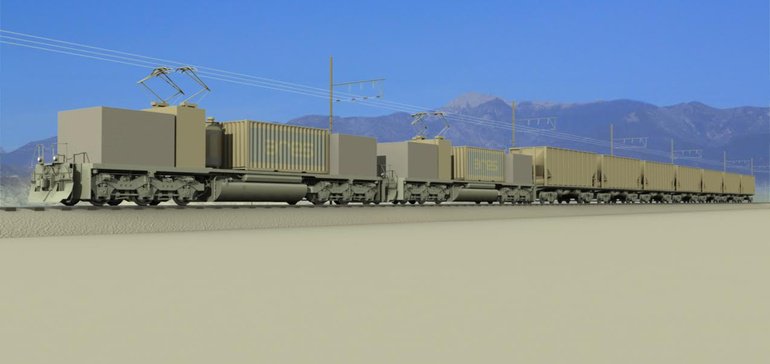Since the 1920s about 2% of the world’s electrical capacity has been supplied by pumped hydro installations. These massive hydroelectric storage batteries can respond within seconds, and improve overall grid efficiency. However hydroelectric facilities can be severely site limited; and cause significant impacts on the environment.

Typical hydroelectric pumped storage facility is a large scale, environmentally intense project
What if we had a large storage device that could be recycled indefinitely with no lasting environmental concerns either? Furthermore, what if something else could be used instead of water, with little environmental impact?
Such a concept is called the Advanced Rail Energy Storage system (ARES); and a 50 MW utility-size system is now in operation in southern Nevada. Check it out. The system is also much cheaper than traditional pumped hydro facilities.

An ARES “shuttle train”
ARES energy storage technology employs a fleet of electric traction drive shuttle-trains, operating on a closed low-friction automated steel rail network to transport a field of heavy masses [rocks, concrete, etc.] between two storage yards at different elevations.

During periods where excess energy is available on the grid, ARES shuttle-trains draw electricity from the grid, which powers their individual axle-drive motors, as they transport a continuous flow of masses (rock/concrete) uphill against the force of gravity to an upper storage yard. When the grid requires energy to meet periods of high demand, this process is reversed. The shuttle-trains provide a continuous flow of masses returning to the lower storage yard with their motors operating as generators, converting the potential energy of the mass’s elevation back into electricity in a highly efficient process.
At the Nevada site, shuttle trains move up and down a change of about 3,000 feet. At the end of the system’s 40-year lifetime, the rails are removed followed by regrading of the land back to original conditions—no lasting environmental impacts. Think about this … large wind turbines could also supply the excess energy to charge up this energy storage system!
Edison’s original electric storage batteries can be considered tiny portable pumped hydro facilities. He realized his electric utility equipment would function more efficiently if it could run all the time, even with the daily ups and downs of electric demand. Energy storage would make it possible to charge batteries for use later during the day … in electric vehicles. Certainly, Edison would like this innovative ARES concept!
Thomas Edison said, “Many of life’s failures are people who did not realize how close they were to success when they gave up.”

Left: Intel-Edison module now available world-wide for developers. Right: The “Tommy” award given by the Edison Innovation Foundation.

